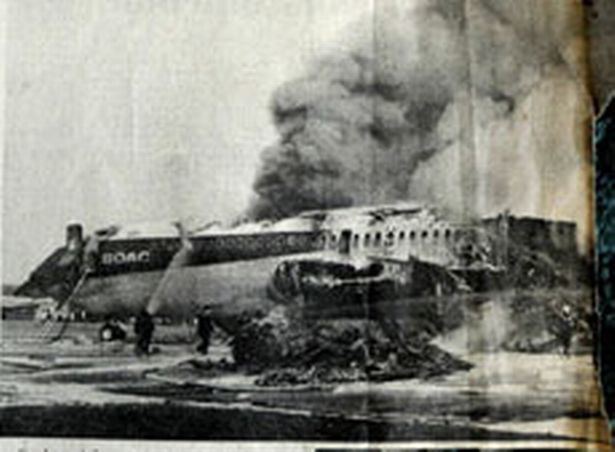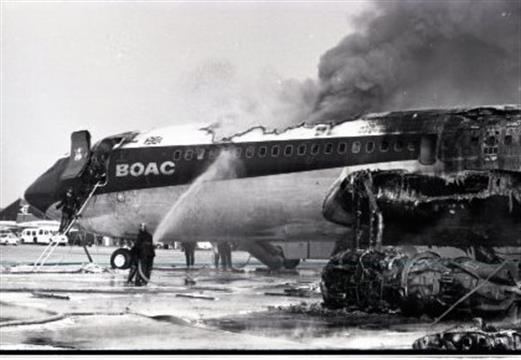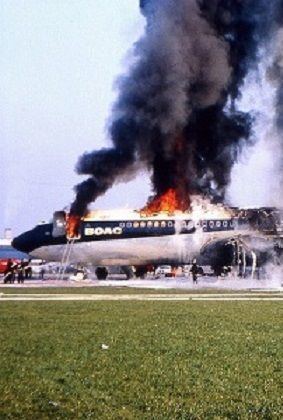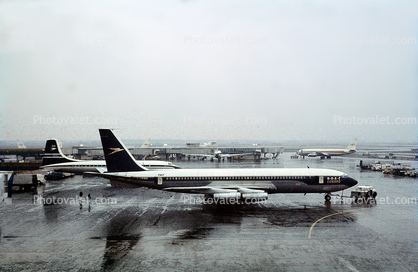Passengers 116 Fatalities 5 Date 8 April 1968 Injuries (nonfatal) 38 | Crew 11 Survivors 122 Number of deaths 5 Survivor 122 | |
 | ||
Summary Fire in number 2 port engine Site Hounslow, United Kingdom Similar 1968 Heathrow BKS Air T, Air France Flight 212, Pan Am Flight 217, South African Airways F, North Central Airlines Fl | ||
BOAC Flight 712 (callsign Speedbird 712) was a British Overseas Airways Corporation service operated by a Boeing 707-465 from London Heathrow Airport bound for Sydney via Zurich and Singapore. On Monday 8 April 1968, it suffered an engine failure on takeoff that quickly led to a major fire. The engine fell off the aircraft in flight. After the aircraft had made a successful emergency landing, confusion over checklists and distractions from the presence of a check captain contributed to the deaths of five of the 127 on board.
Contents

The actions taken by those involved in the accident resulted in the award of the George Cross posthumously to stewardess Barbara Jane Harrison. Two other crew members received awards; a BEM and an MBE. As a result of the accident, BOAC changed the checklists for engine severe failures and engine fires, combining them both into one checklist, the "engine fire or severe failure" checklist.

Flight
Flight 712 took off from Heathrow at 15:27 GMT (16:27 BST), 12 minutes later than scheduled. It had 127 people aboard, including a crew augmented by the addition of an acting flight officer, John Hutchinson, and a check captain for routine performance review of the pilot in command, Captain Cliff Taylor. As well as the passengers, the aircraft was carrying baggage, mail and a radioactive isotope from the Isotope Production Unit at Harwell destined for the University Hospital in Jerusalem.

Seconds after take off from Heathrow's then 9,000 feet (2,700 m) long runway 28L (now 12,008-foot (3,660 m) long and designated 27L), there was an unexpected bang and the aircraft started vibrating. The throttle controlling number two engine was shutting down. While Captain Taylor ordered an engine failure drill, Flight Engineer Thomas Hicks carried out the engine failure drill, but both he and Check Captain Geoffrey Moss reached for the switch to cancel the undercarriage warning horn. At the same time, First Officer Francis Kirkland inadvertently cancelled the fire bell. Hicks reached for, but didn't pull, the engine fire shut-off handle. Moss, observing the fire, exclaimed "Bloody Hell! The wing's on Fire!" A Mayday was broadcast at 15:29.
In the control tower, the takeoff had been observed by John Davis, who saw what he initially thought was the sun reflecting off the aircraft's wing during its initial climb. Davis quickly realised that the aircraft was on fire. Davis instructed Flight 712 to make a left turn, with the intention that the aircraft would land on runway 28L. He hit the "crash button" which alerted the emergency services and declared an aircraft accident. The emergency services were informed of the type of aircraft involved and given a rendezvous point at which they were to assemble.

By this time, the windows on the port side at the rear of the fuselage were beginning to melt. As the aircraft flew over Thorpe the burning engine broke away from its mounting and fell into a gravel pit where some children were playing, without causing any injury. At this time, the undercarriage was lowered and full flap selected. The flaps stopped some three degrees short of their full travel. The aircraft was at a height of 3,000 feet (910 m) and flying at 225 knots (417 km/h). Cabin crew member Jennifer Suares repeated the emergency landing drill for the benefit of the passengers despite not being sure herself that they would actually manage to land before the aircraft exploded.

The crew realised that the aircraft would not last long enough to enable a landing back on 28L, and declared a Mayday. Davis cleared the aircraft to land on runway 05R, which was 7,733 feet (2,357 m) long. He also instructed two other aircraft to perform a go-around, as runway 05R crossed runway 28R, which they were due to land on and Davis did not know whether Flight 712 would be able to stop before reaching that runway. The crew accepted Davis's offer of runway 05R, even though it was much shorter and not equipped with ILS. Taylor was able to safely land the aircraft on 05R, using wheel brakes and reversing the outboard engines' thrust to halt the aircraft. The aircraft touched down about 400 yards (370 m) beyond the threshold and stopped in 1,400 yards (1,300 m). Taylor asked Davis for permission to evacuate, but the cabin crew were already opening the emergency doors. The flight crew started the fire drill, but the port wing exploded before this could be completed. As a result, the fire shut off handles were not pulled, and the booster pumps and electrical supply were left switched on. Due to the short period of time between the Mayday being declared at 15:29 and the aircraft landing at 15:31, there was no time for the emergency services to lay a carpet of foam, which was standard practice at the time.
Evacuation

The cabin crew started the evacuation, even before the plane had come to a halt, via both forward galley doors, both rear doors and the starboard overwing exits. Eighteen passengers escaped via the overwing exits before the fire grew too intense to use that route. The forward port galley door escape slide caught fire before it could be used, but one person jumped from there. 84 people escaped via the starboard galley door. Three of the crew escaped by the emergency cockpit rope. The rear starboard door escape slide had twisted on deployment, so Steward Taylor climbed down to straighten it, leaving stewardess Jane Harrison at the door assisting the passengers. Six passengers escaped via this route before the slide was punctured and deflated. Harrison encouraged the passengers to jump, and pushed out those too frightened to do so. 11 people escaped via this route, and five more escaped via the rear port door before the slide was destroyed. Harrison was last seen alive preparing to jump herself, but then she turned back and disappeared into the burning fuselage in an attempt to save the remaining four female passengers, including a disabled woman and eight-year-old girl. It was these actions which led to the award of the George Cross posthumously to Harrison in recognition of her selfless gallantry. 35 people were injured, and five killed.
Fire-fighting
The first two fire engines to arrive were unable to do much to stop the fire, as the drivers misjudged their distance, and also making foam required the main transfer gearboxes of the fire engines to be operated, which meant that the vehicles were unable to move while doing so. Problems with couplings on the fire hoses exacerbated the situation – the fire hydrants had been regularly painted, and a build up of paint on the coupling threads prevented the hoses from being attached to the hydrants. The driver of a back-up foam tender drove in closer to the burning aircraft and discharged his foam effectively, but the fire had already gained hold by the time this happened.
Passengers
The aircraft was carrying 116 passengers and 11 crew. Five people were killed in the accident: stewardess Barbara Jane Harrison and four passengers, Esther Cohen, who was severely disabled, Catherine Shearer, a young Australian teacher who was seated with her mother (who survived) next to Cohen in the back row of seats, Mary Smith, a widow, and Jacqueline Cooper, an eight-year-old girl whose parents and two brothers escaped, helped by Harrison. All five victims were found at the Inquest of 17 September 1968 to have died of "Asphyxia due to Inhalation of Fire Fumes", and a verdict was returned in all five cases of Accidental Death.
One of the survivors was the pop singer Mark Wynter, who was travelling to Australia for his wedding to Janeece Corlass.
Another survivor was Katriel Katz, Israeli Ambassador to the Soviet Union. Katz had been expelled from the Soviet Union by Andrei Gromyko on 10 June 1967, the last day of the Six-Day War. During the evacuation from the aircraft, Katz was the only passenger to escape through the forward port door, despite the efforts of Hutchinson and Unwin to stop him using that door. The two flight crew were almost carried out through the door by Katz, who was a large man. Katz was seriously injured jumping from the doorway. He was taken to Hillingdon Hospital, where it was initially feared that he would become the sixth victim of Flight 712. Katz recovered after a few days. He died in 1988 aged 80.
Aircraft involved
The aircraft involved in the accident was a Boeing 707–465 registered G-ARWE (manufacturer's serial number 18373, Boeing line number 302). First flown on 27 June 1962, the aircraft was originally to have been operated by Cunard Eagle Airways, but before it entered service it was sold to BOAC-Cunard and was delivered on 7 July 1962. On 21 November 1967 the aircraft suffered an engine failure on take off from Honolulu International Airport. The take off was aborted, and there were no injuries to any of the passengers or crew. At the time of the Heathrow accident, the aircraft had flown for a total of 20,870 hours. The aircraft was insured for £2,200,000 with Lloyd's of London.
Salvage
The nose section of the 707 was salvaged for use on a Convair CV-580 (N21466) for test purposes as part of the Total In Flight Simulator program (TIFS). On 12 April 1969 the nose was airlifted by an Aero Spacelines Guppy from Heathrow to Santa Barbara to support the modification.
Accounts that the nose from G-ARWE was used to repair a damaged TWA 707 are incorrect. G-ARWE's nose was too fire damaged for use as a repair donor for an airliner. TWA's Boeing 707-331B, N28714, (Originally N776TW, c/n 18408) had been hijacked on a flight from Rome to Athens. Its cockpit had been destroyed by a bomb at Damascus, Syria, on 29 August 1968. The rest of the airframe was found to be undamaged. N28714 received a new nose section from Boeing's Renton production line.
Investigation
In the subsequent investigation, metal fatigue was ultimately blamed for the failure of the number five compressor wheel in the number two Rolls-Royce 508 Conway turbofan engine, starting the rapid chain of failures. The crew's omitting to shut off the fuel to the engine was blamed for the rapid growth of the fire and the loss of the aircraft. Check Captain Moss had accidentally cancelled the fire warning bell instead of the undercarriage warning bell. Moss had also issued orders to Captain Taylor, in breach of the normal protocol for his duties. However, the report on the accident also stated that Captain Taylor had briefed Moss to act as an extra set of eyes and ears inside and outside the cockpit. Moss's actions therefore could be seen as acting within that remit. Although Moss had alerted the crew to the fire, none of them were aware that the number 2 engine had fallen off until after the evacuation on the ground.
As a result of the investigation, and lessons learned from the chain of events, BOAC combined the "Engine Fire Drill" and "Engine Severe Failure Drill" checklists into one list, called the "Engine Fire or Severe Failure Drill". Modifications were also made to the checklist, including adding to the checklist confirmation that the fire handles had been pulled.
The aircraft's number 2 port engine No.5097, constructed in 1961, had run for 14,917 hours from new, and had been overhauled in spring 1965 because of vibration caused by metal fatigue that had led to the failure of a stage 8 high-pressure compressor blade. In 1967 the engine had been removed from service because of flame tube deterioration, and as part of the repairs, the low-pressure compressor, of which the number 5 wheel was an original component, was overhauled, but the wheel itself was not tested for fatigue. On 22 November 1967 the engine was bench tested and rejected because of excessive vibration of the high-pressure compressor, but was later released as serviceable following further analysis. After 1,415 hours service on another 707 and modification to the turbine seals, on 5 April 1968 No.5097 became number 2 engine of the port wing of the aircraft, scheduled to fly long-haul to Sydney, Australia, three days later.
Shortly after takeoff at 16.27 BST (15.27 GMT) on 8 April 1968, according to the investigations of Rolls-Royce, the 5th stage low-pressure compressor wheel failed in fatigue at the run out radius of the wheel web with the rim, causing secondary failures to other wheels and other parts of the engine. The wheel then burst through its casing and disconnected the main fuel pipe, igniting the fuel which was being pumped at 50 gallons (approx. 150 kg) per minute. The fire could not be put out because the engine's two extinguishers had become ineffectual following the destruction caused to the engine cowling by the broken compressor casing. The ferocity of the blaze soon after caused the engine pylon to fatally weaken, which when it gave way, led to the engine falling off of the wing. However, the fuel booster pump continued to function, intensifying the fire until it spread to the wing itself, sweeping back from forward of the leading edge towards the tail. Upon landing, the application of reverse thrust and the westerly crosswind on runway 05R blew the flames underneath the wing and set light to the fuselage. The rapidly intensifying fire then spread under the plane and ignited the fuel lines and oxygen tanks, which, within seconds of the aircraft coming to a stop, caused a series of explosions that broke through the fuselage and set fire to the cabin, ultimately resulting in the deaths of five people.
Awards
Queen Elizabeth II awarded Barbara Jane Harrison a posthumous George Cross (GC), the only GC ever presented to a woman in peacetime. Her medal was accepted on her behalf by her father, Alan. Harrison is the youngest ever female recipient of the George Cross. Neville Davis-Gordon was awarded the British Empire Medal for Gallantry (BEM). John Davis was appointed a Member of the Most Excellent Order of the British Empire (MBE).
The citation for Barbara Jane Harrison's GC reads:-
The citation for Neville Davis-Gordon's BEM reads:-
In addition, Air Traffic Control Officer John Davis, who was responsible for Flight 712 and had first spotted the port engine fire from the ground, was appointed MBE.
Captain Cliff Taylor and Acting First Officer John Hutchinson had managed to safely land their aircraft which, having lost an engine, was on fire carrying about 22,000 gallons of fuel, in the most testing of circumstances and almost certainly saved 121 lives. Taylor was recommended for an award by BOAC, but following the publication of the official inquiry report in August 1969, the decision was taken at ministerial level not to recognise any member of the flight crew. Both Taylor and Hutchinson received, along with First Officer Francis Kirkland and Check Captain Geoffrey Moss, but not Flight Engineer Thomas Hicks, commendations from BOAC, and Captain Taylor was awarded the British Airline Pilots Association Gold Medal.
